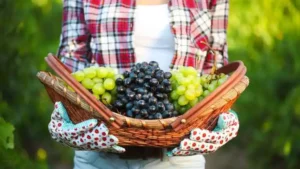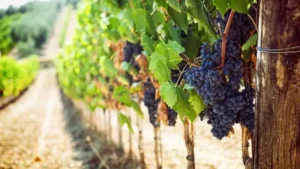Tempranillo Grape, a Spanish winemaking staple, is now gaining global recognition for its versatility and rich flavor.
As wine experts explore Tempranillo’s full potential, it’s driving a vinicultural revolution, transforming the premium wine landscape.
With its rich history and unique traits, Tempranillo has become a symbol of innovation in the world of viticulture.
From its origins in Spain to its growing popularity in wine regions across the globe, Tempranillo is now synonymous with quality, tradition, and forward-thinking winemaking.
In this article, we will delve into the factors that make Tempranillo stand out among other premium grape varieties.
Whether you are a seasoned wine connoisseur or a curious newcomer, understanding the revolutionary impact of Tempranillo will deepen your appreciation for this remarkable grape and the wines it produces.
..
The Origins of Tempranillo and Its Historical Significance
The Early Beginnings of Tempranillo
Tempranillo, often regarded as Spain’s noble grape, boasts a history that stretches back over a millennium, with its origins firmly rooted in the Iberian Peninsula.
The grape’s early presence in this region has been documented as far back as the 9th century, where it played a pivotal role in the development of viticulture in what are now some of Spain’s most famous wine regions.
The grape’s name, Tempranillo, is derived from the Spanish word “temprano,” meaning “early,” aptly describing its tendency to ripen earlier than many other grape varieties.
This characteristic not only allowed it to survive in the varied climates of Spain but also contributed to its widespread cultivation across the country.
..
Tempranillo’s Role in Spain’s Wine Heritage
As viticulture expanded throughout Spain, Tempranillo emerged as a central figure in the production of the country’s most esteemed wines.
In regions like Rioja and Ribera del Duero, Tempranillo became synonymous with quality and tradition.
Rioja, in particular, embraced Tempranillo as its flagship grape, where it was often blended with other varieties like Garnacha and Graciano to create wines of exceptional balance and complexity.
The use of American oak barrels, a practice that began in the 19th century, further distinguished Rioja wines by imparting distinctive flavors of vanilla and coconut, which became hallmarks of the region’s Tempranillo-based wines.
Meanwhile, in Ribera del Duero, Tempranillo, known locally as Tinto Fino, developed a reputation for producing wines with greater concentration and structure, owing to the region’s higher elevation and more extreme climate.
Here, the grape’s thick skins and robust tannins came to the forefront, enabling the production of wines that could age gracefully for decades.
This ability to age and evolve over time has made Tempranillo a cornerstone of Spain’s wine heritage, revered for its capacity to produce wines that not only reflect their terroir but also improve with time.
..
The Evolution of Tempranillo in Modern Winemaking
Tempranillo’s historical significance extends beyond its role in traditional Spanish winemaking.
In recent decades, the grape has become a symbol of innovation and adaptability in the global wine industry.
As winemakers have explored new techniques and approaches to viticulture, Tempranillo has proven to be remarkably versatile.
For example, in the hands of modern winemakers, Tempranillo is no longer confined to the stylistic boundaries of Rioja or Ribera del Duero.
Instead, it is being experimented with in various climates and soils, from the cool, coastal regions of California to the arid plains of Argentina.
These new expressions of Tempranillo often highlight different aspects of the grape’s character, whether it be the fresh, fruit-forward style produced in cooler climates or the richer, more tannic wines that come from warmer regions.
Moreover, the grape’s ability to adapt to sustainable and organic farming practices has further solidified its place in contemporary winemaking.
As consumer demand for wines made with minimal intervention and a focus on terroir continues to grow, Tempranillo’s historical roots, coupled with its modern versatility, ensure that it will remain a key player in the future of wine.
..
Join the “Wine Lovers” Group and receive our content on WhatsApp
.
…
Unique Characteristics of the Tempranillo Grape
Adaptability Across Diverse Climates
Tempranillo’s versatility is one of its most remarkable features, allowing it to thrive in a variety of climates and regions.
This adaptability is crucial in understanding why Tempranillo has become such a popular grape among winemakers around the world.
Whether grown in the sun-drenched vineyards of Spain or the cooler, more temperate regions of the Pacific Northwest, Tempranillo adjusts well, producing wines that reflect the unique terroir of each location.
- Hot, Arid Regions
In warmer climates, such as the central regions of Spain or Australia, Tempranillo tends to produce wines with higher alcohol content and more concentrated flavors. The heat amplifies the grape’s natural sugars, resulting in richer, fuller-bodied wines with robust tannins. - Cool, Coastal Climates
Conversely, in cooler regions like Oregon or Northern Spain, Tempranillo develops more nuanced characteristics.
The grape’s natural acidity is preserved, leading to wines with brighter fruit flavors, a lighter body, and a more refined tannic structure.
..
Flavor Profile: A Symphony of Complex Notes
The flavor profile of Tempranillo is another aspect that sets it apart from other varieties.
Its ability to deliver a broad spectrum of flavors, from fruit-forward notes to more earthy, savory undertones, makes it a favorite among wine enthusiasts.
- Red Fruit Dominance
At the core of Tempranillo’s flavor profile is its red fruit character. Wines made from this grape often exhibit vibrant notes of cherry, plum, and raspberry, which are more pronounced in younger wines.
.. - Earthy and Savory Undertones
As Tempranillo wines age, they develop complex layers of secondary and tertiary aromas, including leather, tobacco, and vanilla.
These flavors are often a result of extended aging in oak barrels, particularly American oak, which imparts additional notes of coconut and spice.
.. - Balanced Acidity and Tannins
The balance of acidity and tannins in Tempranillo is what gives these wines their exceptional aging potential.
The grape’s thick skins contribute to a strong tannic backbone, while its natural acidity ensures that the wines remain fresh and lively, even after many years in the bottle.
..
Aging Potential: A Testament to Quality
One of the most celebrated characteristics of Tempranillo is its ability to age gracefully.
This is a trait that not all grape varieties possess, and it is a significant factor in the prestige associated with Tempranillo wines.
- Youthful Expressions
When young, Tempranillo wines are often bright and fruit-driven, with a vibrant acidity that makes them approachable and enjoyable even without aging. These wines are typically lighter in body and more focused on primary fruit flavors.
.. - Matured Elegance
Over time, Tempranillo’s tannins soften, and its flavors evolve, leading to wines that are richer and more complex.
Aged Tempranillo is known for its velvety texture and a flavor profile that seamlessly integrates fruit, earth, and oak-derived notes.
This transformation is particularly evident in wines from regions like Rioja, where the tradition of aging Tempranillo in oak barrels has been perfected over centuries.
..
Key Growing Regions and the Influence of Terroir
Spain: The Heartland of Tempranillo
Spain remains the unrivaled heartland of Tempranillo, where the grape’s most iconic expressions are found.
The two most prominent regions for Tempranillo in Spain are Rioja and Ribera del Duero, each offering a distinct interpretation of the grape’s potential.
- Rioja
In Rioja, Tempranillo is often blended with other varieties like Garnacha, Mazuelo, and Graciano to create wines with a perfect balance of fruit, acidity, and oak influence.
The region is famous for its use of American oak barrels, which impart flavors of vanilla, coconut, and spice, adding layers of complexity to the wine.
The Rioja classification system, which includes Crianza, Reserva, and Gran Reserva, reflects the varying degrees of aging and oak influence, with Gran Reserva representing the pinnacle of aged Tempranillo.
.. - Ribera del Duero
In contrast, Ribera del Duero’s higher altitude and more extreme climate produce Tempranillo wines that are bolder and more tannic, often with higher alcohol content.
Here, the grape, locally known as Tinto Fino or Tinta del País, is typically used to create powerful, structured wines that are capable of aging for decades.
The region’s focus on longer maceration periods and aging in both American and French oak gives these wines a distinct profile, characterized by intense dark fruit flavors and a firm, yet refined, tannic structure.
..
Portugal: Tinta Roriz and the Role in Port Wines
Across the border in Portugal, Tempranillo is known as Tinta Roriz, one of the key varieties in the production of Port wine.
In the Douro Valley, Tinta Roriz is prized for its ability to add structure and depth to Port blends, contributing tannins, color, and flavors of dark berries and earth.
Additionally, in regions like Dão, Tinta Roriz is used to produce rich, full-bodied red wines that highlight the grape’s versatility in different winemaking styles.
- Douro Valley
In the Douro, the steep, terraced vineyards and harsh growing conditions bring out the best in Tinta Roriz, resulting in wines that are concentrated and full of character.
The region’s hot summers and cold winters, coupled with the schistous soils, contribute to the development of intense, complex flavors, making Tinta Roriz a vital component in both table wines and fortified Port.
..
The New World: Diverse Expressions of Tempranillo
In the New World, Tempranillo has found success in regions like California and Australia, where winemakers have embraced the grape’s adaptability and potential for producing high-quality wines.
- California’s Central Coast
In California, particularly in the Central Coast AVA, Tempranillo thrives in the cool, coastal climate, producing wines with bright acidity and vibrant red fruit flavors.
The region’s long growing season allows for a slow, even ripening of the grapes, resulting in wines that are elegant and well-balanced, with a lighter body than their Spanish counterparts.
.. - Australia
Meanwhile, in Australia, Tempranillo has been adopted in regions like McLaren Vale and the Barossa Valley, where the grape benefits from the warm, dry climate.
Australian Tempranillo wines tend to be richer and more fruit-forward, with riper tannins and a more approachable style.
The combination of old-world tradition and new-world innovation has led to a unique expression of Tempranillo that appeals to a global audience.
..
The Influence of Terroir on Tempranillo’s Character
Terroir plays a crucial role in shaping the flavor profile of Tempranillo wines.
The interaction between climate, soil, and topography in each region imparts unique characteristics to the grape, influencing everything from acidity levels to tannin structure.
- Climate: The climate of a region dictates the ripening process of the grapes. In cooler climates, Tempranillo tends to retain higher acidity and develops more delicate, nuanced flavors, while in warmer climates, the grape produces bolder, more concentrated wines.
.. - Soil Composition: The type of soil also affects the grape’s growth and the resulting wine. For example, Tempranillo grown in limestone-rich soils often exhibits more minerality, while grapes from clay soils may have a more robust, earthy flavor.
.. - Elevation and Aspect: Higher elevation vineyards, like those in Ribera del Duero, experience greater diurnal temperature variation, which helps preserve acidity and concentrate flavors, resulting in wines with a more structured profile.
..
Comparing Tempranillo to Other Premium Grapes
Tempranillo vs. Cabernet Sauvignon: Subtlety vs. Boldness
When comparing Tempranillo to Cabernet Sauvignon, one of the most striking differences lies in their approach to flavor and structure.
Cabernet Sauvignon is renowned for its bold, assertive character, often characterized by deep, concentrated fruit flavors like blackcurrant and blackberry, coupled with strong tannins and high acidity.
These attributes make Cabernet Sauvignon a powerhouse, particularly in regions like Bordeaux and Napa Valley, where it thrives in producing age-worthy wines with remarkable depth and complexity.
- Subtle Complexity of Tempranillo
In contrast, Tempranillo offers a more subtle, layered expression.
While it can still produce wines with significant tannic structure and aging potential, Tempranillo is often more reserved in its fruit expression, leaning towards red fruits like cherry and plum, with an underlying earthiness that adds depth.
This subtlety allows Tempranillo to showcase the influence of its terroir more prominently, making it a true reflection of its growing environment.
..
Tempranillo vs. Pinot Noir: Robustness vs. Elegance
Pinot Noir, another highly esteemed grape variety, is celebrated for its elegance, light body, and aromatic complexity.
Originating from Burgundy, Pinot Noir is often described as delicate, with a focus on red fruit flavors like strawberry and raspberry, complemented by floral and earthy notes.
Its thin skins result in wines with lower tannins and lighter color, making it a favorite for those who appreciate finesse over power.
- The Robust Character of Tempranillo
While Pinot Noir captivates with its grace, Tempranillo impresses with its robustness.
Tempranillo’s thicker skins contribute to a wine with more color, body, and tannin, making it a heartier option that can stand up to richer, more substantial dishes.
Additionally, Tempranillo’s natural acidity and tannin levels make it a better candidate for extended aging, during which it develops complex tertiary flavors such as leather, tobacco, and spice, adding to its appeal for collectors.
..
Tempranillo vs. Merlot: Versatility vs. Approachability
Merlot, often viewed as one of the most approachable red wines, is known for its soft, plush texture and fruit-forward profile.
With flavors typically ranging from plums to chocolate, Merlot is less tannic than both Cabernet Sauvignon and Tempranillo, making it a popular choice for those who prefer smoother, more accessible wines.
Merlot’s versatility also allows it to thrive in a variety of climates, producing wines that can range from simple and easy-drinking to complex and structured.
- Tempranillo’s Balance of Versatility and Complexity
Although Tempranillo shares Merlot’s versatility, its flavor profile offers more complexity and a greater range of expressions depending on the region and winemaking style.
While Merlot often appeals to those seeking a wine that is immediately enjoyable, Tempranillo’s combination of fruit, acidity, and tannin offers a broader spectrum of experiences, from youthful and vibrant to aged and sophisticated.
This balance of versatility and complexity enables Tempranillo to bridge the gap between easy-drinking and age-worthy wines, making it a standout choice among premium grape varieties.
..
Tempranillo as a Bridge Between Old and New World Wines
Tempranillo’s unique position in the world of premium wines is further emphasized by its ability to act as a bridge between Old and New World styles.
It combines the structure and age-worthiness commonly associated with Old World wines, such as those from Bordeaux, with the fruit-forward, approachable nature of many New World wines.
This duality allows Tempranillo to resonate with a broad audience, offering something for both traditionalists who value historical significance and modern wine lovers who appreciate innovation and versatility.
..
Market Trends and the Future of Tempranillo
The Rising Popularity of Tempranillo in the Global Market
In recent years, the global wine market has witnessed a significant increase in the popularity of Tempranillo.
This surge in interest is largely attributed to the grape’s versatility and its ability to produce wines that cater to a wide range of tastes and preferences.
From young, vibrant reds to complex, aged wines, Tempranillo has proven itself capable of delivering quality across various price points.
This broad appeal has made Tempranillo a favorite not only among seasoned wine enthusiasts but also among newer wine consumers who are eager to explore different varietals.
- Expansion Beyond Traditional Markets
Historically, Tempranillo was primarily associated with Spain.
However, its reputation has grown internationally, with countries like the United States, Australia, and Argentina embracing the grape and producing outstanding Tempranillo wines.
The expansion of Tempranillo into these new markets has further fueled its global popularity, as consumers become more aware of the diverse expressions this grape can offer.
..
Sustainability and Organic Farming: A Perfect Match for Tempranillo
As the wine industry increasingly shifts towards sustainability, Tempranillo’s natural characteristics make it particularly well-suited for organic and biodynamic farming practices.
The grape’s resilience to diseases and pests, combined with its adaptability to different climates and soils, allows it to thrive with minimal intervention.
This aligns perfectly with the growing consumer demand for wines that are produced in an environmentally responsible manner.
- Environmental Stewardship
Many producers are now focusing on sustainable practices, such as reducing the use of chemical fertilizers and pesticides, conserving water, and promoting biodiversity in the vineyard.
Tempranillo’s ability to flourish under these conditions has made it a popular choice for wineries that prioritize environmental stewardship.
This trend is expected to continue as consumers become more conscious of the environmental impact of their wine choices.
..
The Future of Tempranillo: Innovation and Diversity
Looking ahead, the future of Tempranillo is filled with potential.
As winemakers around the world continue to experiment with this versatile grape, we can expect to see a wider variety of Tempranillo wines on the market.
This innovation is likely to take several forms, from exploring new terroirs and winemaking techniques to creating unique blends that highlight Tempranillo’s strengths.
- New Terroirs and Winemaking Techniques
Winemakers are increasingly exploring the potential of Tempranillo in non-traditional regions, which could lead to exciting new expressions of the grape.
For instance, cooler climate regions may produce Tempranillo wines with higher acidity and more pronounced fruit flavors, while warmer regions may focus on producing bold, full-bodied wines with intense concentration.
.. - Blending Opportunities
Tempranillo’s versatility also makes it an excellent candidate for blending. By combining Tempranillo with other varietals, winemakers can create innovative blends that offer a new twist on traditional wine styles.
These blends not only showcase Tempranillo’s adaptability but also appeal to consumers looking for something unique and different.
..
Consumer Demand and Market Expansion
As consumer interest in authentic and diverse wine experiences grows, Tempranillo’s market share is expected to expand further.
The grape’s ability to deliver high-quality wines that reflect their terroir, combined with its alignment with sustainability trends, positions Tempranillo to play a significant role in the future of the global wine industry.
- Affordability Meets Quality
Another factor contributing to Tempranillo’s success is its ability to deliver excellent quality at various price points.
This accessibility makes it an attractive option for both casual wine drinkers and connoisseurs, ensuring that Tempranillo remains relevant and in demand across different market segments.
..
In summary, Tempranillo is transforming the wine industry with its rich history, distinct characteristics, and adaptability across diverse terroirs.
This grape’s growing popularity, combined with its suitability for sustainable practices, underscores its significant role in the future of premium wines.
Whether you are a seasoned collector or a curious newcomer, delving into the world of Tempranillo offers a unique and rewarding experience, showcasing the perfect blend of tradition and innovation in winemaking.
..
….

Andreza Morazán
Wine Enthusiast and Founder of the Wine in the Talk Blog
Follow Us on Social Media
..
Most Read
..







